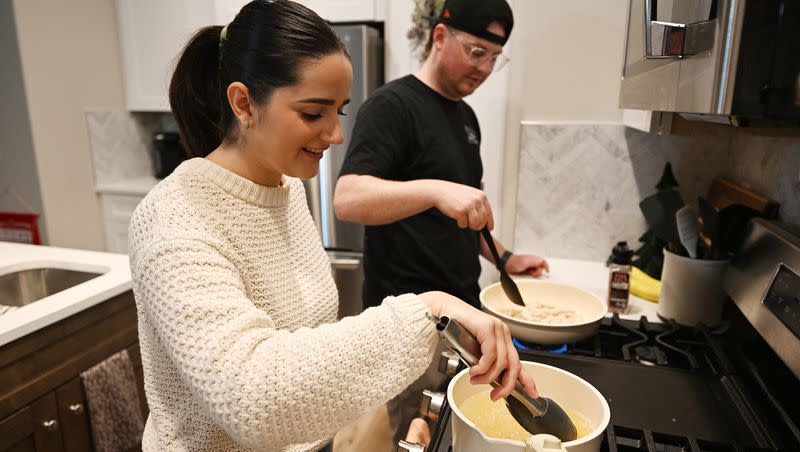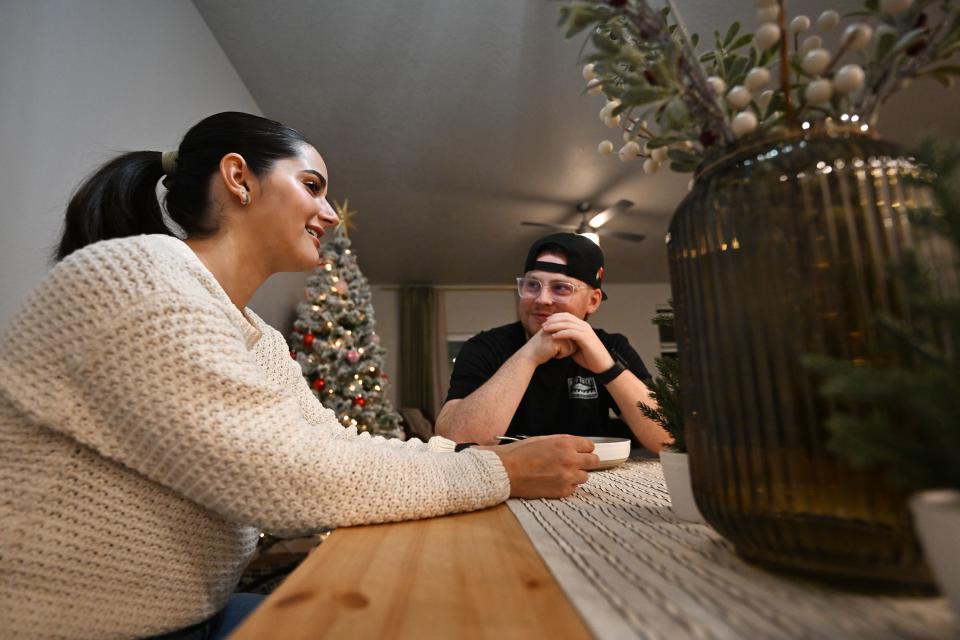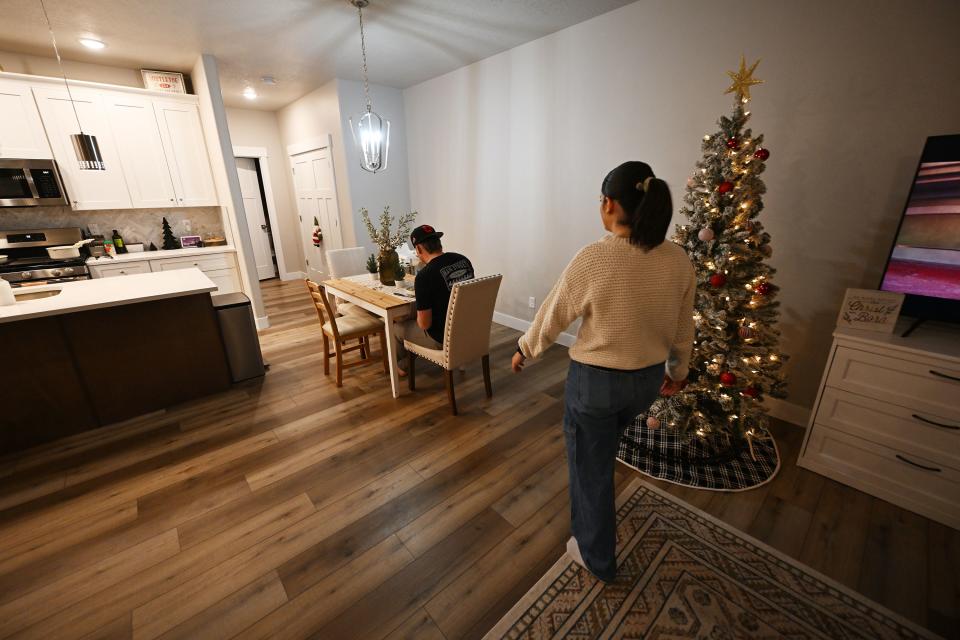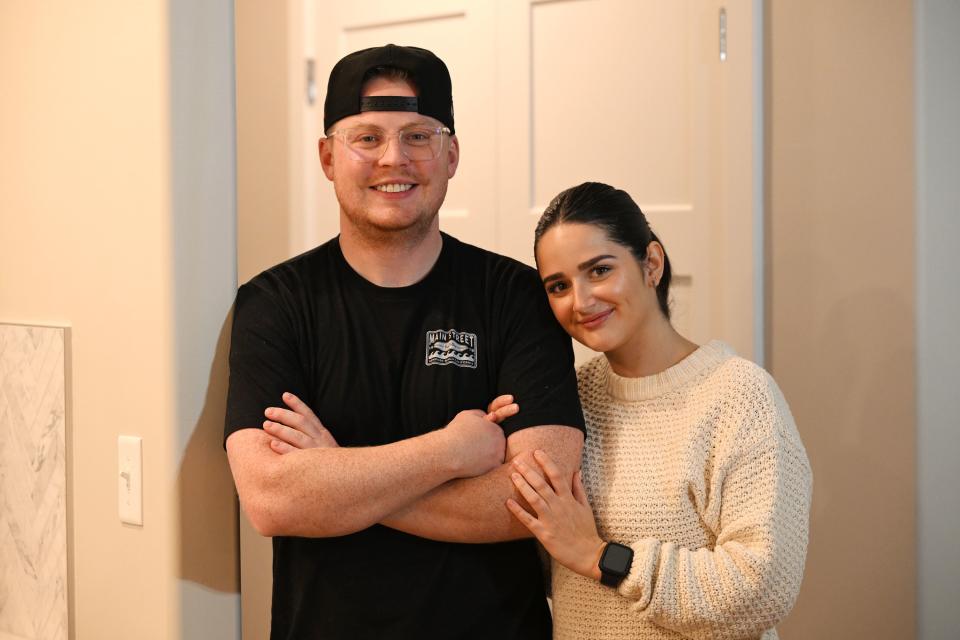Utah funded $50 million for a new first-time homebuyer program. Is it working?

Tough and unpredictable.
Those are the two words Kaitlyn and Zach Gordon used to describe their experience trying to buy a home over the past three years before they were finally able to make it happen this summer.
They were done renting. The parents of two toddlers were fed up trying to raise their family of four in a small basement apartment with unpredictable rent increases and maintenance issues. At one point, it flooded with sewage water. After getting two new landlords in the course of a year, their rent went up to $1,500 a month.
But over the course of those three years, they also watched mortgage interest rates skyrocket from 3% during the pandemic to over 7% this year. Meanwhile, Utah’s home prices have remained brutally high, only dipping slightly amid today’s housing market’s slowdown.
They were looking for a home at or under $400,000 — but they wanted to stay in Utah County, and it was slim pickings.
“We were laughing with one of my friends about trying to find a house and how terrible it is to find something worth your money,” Kaitlyn Gordon said. But that’s when they saw it online, the first day it hit the market. A four-bedroom, three-bathroom townhome in a new development near the base of Spanish Fork Canyon. It was a bit pricier than they wanted to pay, but they figured they might as well check it out.

Related
They were the first ones to walk through the home. It was “surreal,” Zach Gordon said, because it would be such a huge upgrade from their basement apartment. Kaitlyn Gordon was “giddy,” smitten by the tiling and the dual vanity in the master bathroom. Plus it checked all her boxes — a spare bedroom, roomy enough to host family visits, and it even had a garage.
The second time they walked through it, “I felt at home,” Zach Gordon said.
“I didn’t feel stressed out, like, ‘Oh my gosh we’re going to double our monthly payment,’” he said. “I didn’t have any of those thoughts. I felt at peace, I felt calm, I felt like this would be a great place to raise our family. I was more excited than nervous or scared.”
When they heard five other families were scheduled to see the home that day, Kaitlyn Gordon said she felt territorial. “I didn’t want to lose it. I didn’t want someone else to have it. I was like, ‘No, this is mine.’” So they put in an offer then and there.
They got it for $440,000.
The Gordons were first-time homebuyers, purchasing a newly built home that was priced just under $450,000. They hit all the qualifications for Utah’s brand new first-time homebuyer program that had just started in mid-July. Their loan officer recognized that, and told them they should apply.
It was an easy process, the Gordons said, and they ultimately qualified for a $20,000 loan, which they used to bolster their down payment and buy down their interest rate from 7.5% to 6.25%, which meant the difference between hundreds of dollars a month for their mortgage payment. It saved them “close to $400 to $500 a month,” Zach Gordon said. Now, their monthly payment for their mortgage is $2,691.
“Without the (rate) buy-down and additional down payment, I don’t think we would have been able to buy this place,” Zach Gordon said. “It made all the difference.”

Utah’s new first-time homebuyer program
The Gordons are among the first several hundred Utahns that have taken advantage of Utah’s new first-time homebuyer program. It began in July after the 2023 Utah Legislature passed and funded SB240, a bill sponsored by Senate President Stuart Adams that used $50 million in state money to help Utahns afford homes while also encouraging homebuilders to continue adding to the state’s housing stock.
The First-time Homebuyer Assistance Program offers up to $20,000 loans to each eligible homebuyer to help fund down payments, closing costs or buying down interest rates. The $50 million is expected to help about 2,500 buyers.
The program has been up and running for about four months so far. Has it been working?
Today’s housing market is an even more challenging environment than when lawmakers approved and funded this program, but so far it’s helped hundreds of Utahns, with plenty of the $50 million in assistance still available.
By the numbers
As of mid-November, the program has helped 460 Utah families, with 355 applications funded to the tune of nearly $6.7 million and 105 reservations awaiting funds totaling $2.1 million, according to the program’s administrator, Utah Housing Corporation. About 1,860 slots remain.
It’s a “really strong” start, said David Damschen, president and CEO of Utah Housing Corporation.
“The people that are buying homes using this program, the vast majority of them would not have been in a position to buy a home were it not for the program,” he said.
With over 400 homes that have so far been funded by the program at an average price of $381,115, the program has helped facilitate the purchase of over $150 million in housing stock. It’s helping builders and buyers in a challenging market environment for both.
“This is me being very hopeful, but if these builders take that ($150 million) and they build more affordable units, that’s what we want to have happen,” Damschen said. “We think this program has made a pretty high impact when you think about the way interest rates have been rising.”
Three years ago, one of the biggest obstacles for first-time homebuyers was lack of a down payment — but today it’s a different story, Damschen said.
“These high interest rates are really proving to be the primary obstacle,” he said, noting that roughly 60% of the loans that Utah Housing Corporation issues involve a rate buy-down. “That is a huge key to achieving homeownership in this market,” he added, noting some of those buy-downs are funded by the builder while some are funded by the seller.
Related
Damschen noted Utah Housing Corporation offers other first-time homebuyer options for down payment assistance, and Utah’s new assistance fund can be used in conjunction with those other existing programs.
“So you can use the whole $20,000 to buy down the interest rate, and then our regular down payment assistance (program) is a fully amortizing 30-year second mortgage,” he said.
Most of the applicants so far have received nearly the full $20,000 loan amount the program offers individual families. The average annual income of recipients has been $90,500.
To anyone discouraged by today’s market, Damschen said it’s important to realize “that despite these crazy interest rates, they can still achieve homeownership.”
“People shouldn’t just wait for rates to come way down because we don’t know if or when that’s going to happen,” he said. “So take a look at your options and know that it’s achievable when maybe you thought it wasn’t.”
What types of homes are getting assistance?
The program was tailored toward new construction with the intention of incentivizing more builders to build homes priced under $450,000. It’s meant to not just prop up homebuyer demand, but create more supply to not exacerbate Utah’s housing shortage.
“This program is in the sweet spot, and we think it’s working very effectively,” Damschen said.
Over 60% of the homes so far funded through the program are townhomes, nearly 21% are single-family homes, and 18% are condominiums, according to the Utah Housing Corporation.
The top cities where these properties are being purchased are Saratoga Springs (16%), Spanish Fork (7%), Magna (6%), Eagle Mountain (6%) and Riverton (5%). The other 60% are scattered throughout Utah.
A large portion of the homes being purchased through the program are located in Utah County, at 42%. The rest are in Salt Lake County (17%), Washington County (9%) and Tooele County (8%), while the other 24% are in other counties across the state.
According to Utah Housing Corporation’s records, D.R. Horton and Edge Homes are building the most homes that have qualified for the program.
Time will tell whether the program incentivizes more builders to construct more homes priced below $450,000 and whether that can make a significant impact on Utah’s housing problems.
“You could make the case that the market is or was shifting in that direction even without this program, that’s fine,” Damschen said. “But this program is certainly an accelerant in terms of providing an added incentive to builders to focus on that end of the market.”
Eligible homes were already in the building pipeline before the creation of the program, so he said it will be interesting to see over the next year or so if more contractors start building homes in that price range.
Is the program funding actual ‘affordable’ homes?
In Salt Lake County, the median price of all home types was $520,000 in August, according to the Salt Lake Board of Realtors. Even though the program’s $450,000 cap is below that median price, is that what Utahns consider an affordable home?
In today’s market? Yes, the Gordons said. “But it’s a stretch,” Kaitlyn Gordon added. Her husband agreed, saying it’s probably “on that border of becoming out of reach of some people.”
It was fairly difficult to find many newly built homes below $450,000 anyway, the Gordons said, especially one with the number of rooms they were looking for when they wanted to stay in Utah County.

“It’s hard,” Kaitlyn Gordon said, noting that she has sisters who have bought in the last three or four years, “and for what they bought is equivalent to (our townhome), but it was like half the price.”
“But for today, this is really good for our money’s worth, especially starting out,” she said. “Now, did I ever think about spending $440,000 on a home? Not right away. But I feel like it’s worth it, especially if you can get a little bit of assistance, to just be able to get a start.”
Related
Owning their own home — especially a new build — offered them more stability and predictability, without having to worry about trying to renovate a fixer-upper.
“The benefits of being a homeowner outweigh the benefits of being renters, even if we are going to pay a little bit more up front,” Zach Gordon said. “You know, the market can change. We can eventually refinance, pay back the loan from our equity and our month-to-month payment will be a little bit better.”
Asked whether Utahns have been struggling to find units under that $450,000 cap, Damschen said, “We haven’t gotten to the point yet where there are people that are out shopping around and they haven’t been able to find a unit that they intend to purchase.”
To learn more about the program, contact Utah Housing Corporation at 801-902-8200 or visit www.utahhousingcorp.org.

